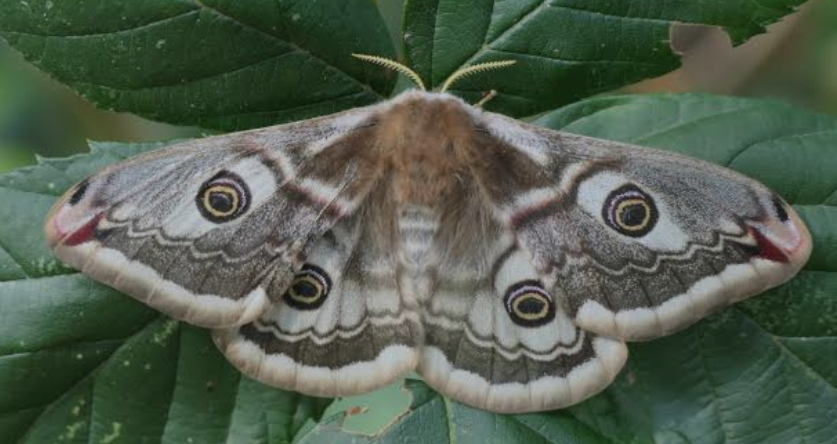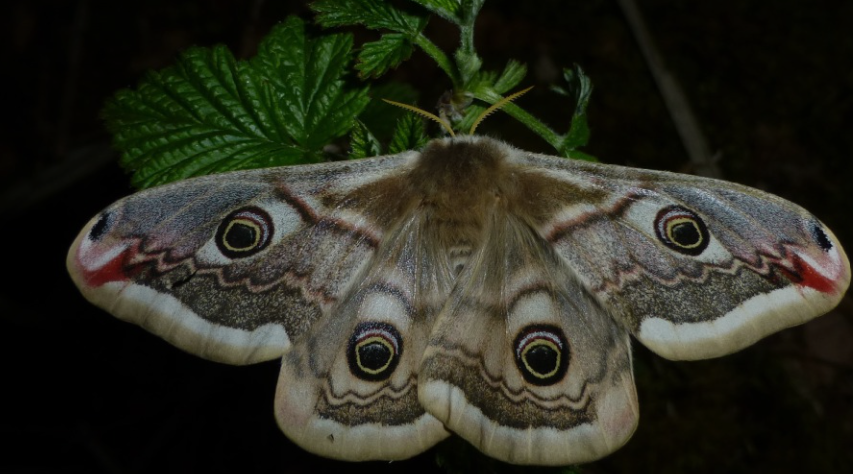
Classification
The Emperor Moth (Saturnia pavonia) belongs to the family Saturniidae, a group known as giant silk moths, which are famous for their large size and eye-catching wing patterns. It is part of the genus Saturnia within the order Lepidoptera, which encompasses all moths and butterflies. This species is one of Europe’s most striking native moths and is closely related to other prominent silk moths, including the Luna and Cecropia moths in North America.
Identifying Characteristics
The Emperor Moth is a medium-sized moth, with a wingspan ranging from 2 to 3 inches (50–75 mm). Its wings are marked with eye-like patterns, or ocelli, which serve to deter predators. Males and females show sexual dimorphism: males are smaller with feathery antennae used to detect female pheromones, while females are larger and more robust. The forewings are generally reddish-brown with intricate markings, and the hindwings display large, vivid eyespots on a paler background. The body is stout and covered in fine hairs, enhancing camouflage and protection.
Distribution
The Emperor Moth is native to Europe and parts of western Asia, with populations found from the British Isles through Scandinavia and into central Europe. It inhabits a variety of temperate habitats where its host plants are available, including heathlands, moorlands, open woodlands, and hedgerows. It is one of the most widespread native silk moths in these regions.
Migration & Habitat
The Emperor Moth is non-migratory, generally remaining in the local area where it hatches and matures. Its preferred habitats include heathlands, grasslands, open woodlands, and moorlands, particularly areas with shrubs and low-growing vegetation. Moths are largely nocturnal, resting on vegetation during the day where their wing patterns provide camouflage against predators.
Predators & Threats
Predators of the Emperor Moth include birds, small mammals, and predatory insects, with the eye patterns on the wings helping to startle or misdirect potential attackers. Additional threats include habitat loss, overgrazing, and pesticide use, which can reduce the availability of host plants and suitable breeding sites. Despite these pressures, populations remain stable in many protected or undisturbed areas.
Lifespan of Adults
Adult Emperor Moths have a short lifespan of about 1–2 weeks. They do not feed, relying entirely on energy reserves accumulated during the larval stage. Their primary purpose is reproduction, with males actively searching for females using pheromone cues. Females focus on laying eggs on suitable host plants to ensure the next generation’s survival.
Host Plants & Diet
Caterpillars of the Emperor Moth feed on a variety of low shrubs and herbaceous plants, including heather (Calluna vulgaris), gorse (Ulex spp.), bramble (Rubus spp.), and hawthorn (Crataegus spp.). The larvae grow rapidly, passing through multiple instars before pupating in a cocoon attached to vegetation. Adults, however, do not feed and depend entirely on stored nutrients from the larval stage to sustain them through mating and egg-laying.
Life Cycle of the Emperor Moth

Egg Stage
The life cycle begins when the female Emperor Moth lays small, pale green eggs on the leaves or stems of suitable host plants, such as heather, gorse, bramble, or hawthorn. Eggs are usually laid in clusters to maximize the chances of survival. Depending on temperature and environmental conditions, the eggs hatch in about 7–14 days.
Larval (Caterpillar) Stage
Once hatched, the larvae emerge as small caterpillars that feed voraciously on the leaves of their host plants. As they grow, they go through several instars (molts), becoming larger and more vividly colored with distinctive markings that help them blend with foliage. The larval stage lasts several weeks, during which the caterpillars accumulate energy reserves needed for metamorphosis. Predation by birds and insects is a significant threat at this stage.
Pupal Stage
After reaching full size, the caterpillar spins a cocoon, usually attached to low vegetation, leaf litter, or twigs. Inside the cocoon, the caterpillar enters the pupal stage, undergoing complete metamorphosis to transform into an adult moth. This stage can last several weeks in summer, or through the winter in cooler climates, with pupae overwintering to emerge the following spring.
Adult Stage
The adult Emperor Moth emerges from the cocoon with fully formed wings. Adults are nocturnal and do not feed, relying entirely on fat reserves accumulated during the larval stage. Their lifespan is short, about 1–2 weeks, during which their sole purpose is mating and reproduction. Males actively seek females using their feathery antennae to detect pheromones, while females focus on laying eggs to continue the next generation.